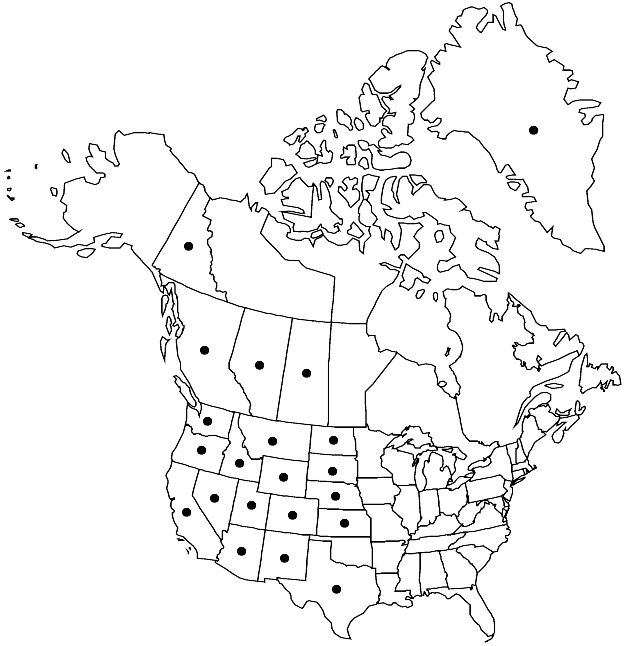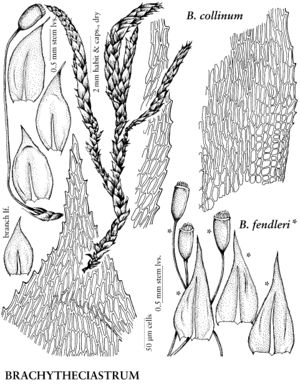Difference between revisions of "Brachytheciastrum collinum"
Arctoa 11: 260. 2003.
FNA>Volume Importer |
imported>Volume Importer |
||
| (6 intermediate revisions by 2 users not shown) | |||
| Line 9: | Line 9: | ||
|special_status={{Treatment/ID/Special_status | |special_status={{Treatment/ID/Special_status | ||
|code=F | |code=F | ||
| − | |label= | + | |label=Illustrated |
}} | }} | ||
| − | |basionyms={{Treatment/ID/ | + | |basionyms={{Treatment/ID/Basionym |
|name=Hypnum collinum | |name=Hypnum collinum | ||
|authority=Schleicher ex Müller Hal. | |authority=Schleicher ex Müller Hal. | ||
| + | |rank=species | ||
| + | |publication_title=Syn. Musc. Frond. | ||
| + | |publication_place=2: 429. 1851 | ||
}} | }} | ||
|synonyms={{Treatment/ID/Synonym | |synonyms={{Treatment/ID/Synonym | ||
|name=Brachythecium collinum | |name=Brachythecium collinum | ||
|authority=(Schleicher ex Müller Hal.) Schimper | |authority=(Schleicher ex Müller Hal.) Schimper | ||
| − | }}{{Treatment/ID/Synonym | + | |rank=species |
| + | }} {{Treatment/ID/Synonym | ||
|name=B. collinum var. idahense | |name=B. collinum var. idahense | ||
|authority=(Renauld & Cardot) Grout | |authority=(Renauld & Cardot) Grout | ||
| − | }}{{Treatment/ID/Synonym | + | |rank=variety |
| + | }} {{Treatment/ID/Synonym | ||
|name=B. idahense | |name=B. idahense | ||
|authority=Lesquereux | |authority=Lesquereux | ||
| − | }}{{Treatment/ID/Synonym | + | |rank=species |
| + | }} {{Treatment/ID/Synonym | ||
|name=H. hillebrandii | |name=H. hillebrandii | ||
| − | |authority= | + | |authority= |
| + | |rank=species | ||
}} | }} | ||
|hierarchy=Brachytheciaceae;Brachytheciastrum;Brachytheciastrum collinum | |hierarchy=Brachytheciaceae;Brachytheciastrum;Brachytheciastrum collinum | ||
| Line 41: | Line 48: | ||
|elevation=low to high elevations (0-3700 m) | |elevation=low to high elevations (0-3700 m) | ||
|distribution=Greenland;Alta.;B.C.;Sask.;Yukon;Ariz.;Calif.;Colo.;Idaho;Kans.;Mont.;Nebr.;Nev.;N.Mex.;N.Dak.;Oreg.;S.Dak.;Tex.;Utah;Wash.;Wyo.;Mexico (Baja California;Chihuahua);Europe;Asia;n Africa. | |distribution=Greenland;Alta.;B.C.;Sask.;Yukon;Ariz.;Calif.;Colo.;Idaho;Kans.;Mont.;Nebr.;Nev.;N.Mex.;N.Dak.;Oreg.;S.Dak.;Tex.;Utah;Wash.;Wyo.;Mexico (Baja California;Chihuahua);Europe;Asia;n Africa. | ||
| − | |discussion=<p>Although stems of Brachytheciastrum collinum are usually julaceous, the leaves are sometimes well spaced, making some populations difficult to distinguish from Brachythecium bolanderi. In this case, the rather extensive alar group and the autoicous sexual condition of B. collinum are helpful, as well as the more abruptly short-acuminate leaves. Some authors distinguish B. collinum and B. fendleri by the non-plicate leaves of the former. However, some collections, for example New Mexico, Santa Fe County, Buck 39717, have plicate leaves, while leaves of B. fendleri are usually smooth.</p> | + | |discussion=<p>Although stems of <i>Brachytheciastrum collinum</i> are usually julaceous, the leaves are sometimes well spaced, making some populations difficult to distinguish from <i>Brachythecium bolanderi</i>. In this case, the rather extensive alar group and the autoicous sexual condition of <i>B. collinum</i> are helpful, as well as the more abruptly short-acuminate leaves. Some authors distinguish <i>B. collinum</i> and <i>B. fendleri</i> by the non-plicate leaves of the former. However, some collections, for example New Mexico, Santa Fe County, Buck 39717, have plicate leaves, while leaves of <i>B. fendleri</i> are usually smooth.</p> |
|tables= | |tables= | ||
|references= | |references= | ||
| Line 50: | Line 57: | ||
-->{{#Taxon: | -->{{#Taxon: | ||
name=Brachytheciastrum collinum | name=Brachytheciastrum collinum | ||
| − | |||
|authority=(Schleicher ex Müller Hal.) Ignatov & Huttunen | |authority=(Schleicher ex Müller Hal.) Ignatov & Huttunen | ||
|rank=species | |rank=species | ||
| Line 63: | Line 69: | ||
|publication title=Arctoa | |publication title=Arctoa | ||
|publication year=2003 | |publication year=2003 | ||
| − | |special status= | + | |special status=Illustrated |
| − | |source xml=https:// | + | |source xml=https://bitbucket.org/aafc-mbb/fna-data-curation/src/2e0870ddd59836b60bcf96646a41e87ea5a5943a/coarse_grained_fna_xml/V28/V28_635.xml |
|genus=Brachytheciastrum | |genus=Brachytheciastrum | ||
|species=Brachytheciastrum collinum | |species=Brachytheciastrum collinum | ||
Latest revision as of 21:37, 5 November 2020
Plants small, in loose to dense tufts, green usually only when very young, pale yellow or brownish yellow with age. Stems 2–4 cm, creeping to ascending, in dense tufts erect, terete-foliate, julaceous or subjulaceous, irregularly pinnate, branches to 4 mm, terete-foliate. Stem leaves appressed proximally, closely imbricate, straight to falcate, ovate to broadly ovate-lanceolate, not to rarely moderately plicate, 0.5–1(–1.5) × 0.2–0.5(–0.7) mm; margins plane or recurved proximally, coarsely serrate almost to base; apex abruptly or rarely gradually short-acuminate, acumen somewhat spreading to reflexed, often homomallous to falcate-secund; costa to 40–70% leaf length, occasionally almost absent, terminal spine absent; alar cells subquadrate, 8–20 × 9–11 µm, region small, of 10 × 4–6 cells, distinctly delimited; laminal cells elongate to linear, 25–60 × 4–7 µm; basal cells almost undifferentiated. Seta reddish orange, 0.6–1.4 cm, slightly roughened, sometimes almost smooth except basal 1/4. Capsule slightly inclined to horizontal, reddish orange, ovate to subcylindric, 1–1.8 mm; endostome basal membrane 1/3 endostome length or longer, cilia as long as segments. Spores 9–12 µm.
Habitat: Soil, rock, xeric to mesic sunny to moderately shaded habitats
Elevation: low to high elevations (0-3700 m)
Distribution

Greenland, Alta., B.C., Sask., Yukon, Ariz., Calif., Colo., Idaho, Kans., Mont., Nebr., Nev., N.Mex., N.Dak., Oreg., S.Dak., Tex., Utah, Wash., Wyo., Mexico (Baja California, Chihuahua), Europe, Asia, n Africa.
Discussion
Although stems of Brachytheciastrum collinum are usually julaceous, the leaves are sometimes well spaced, making some populations difficult to distinguish from Brachythecium bolanderi. In this case, the rather extensive alar group and the autoicous sexual condition of B. collinum are helpful, as well as the more abruptly short-acuminate leaves. Some authors distinguish B. collinum and B. fendleri by the non-plicate leaves of the former. However, some collections, for example New Mexico, Santa Fe County, Buck 39717, have plicate leaves, while leaves of B. fendleri are usually smooth.
Selected References
None.
